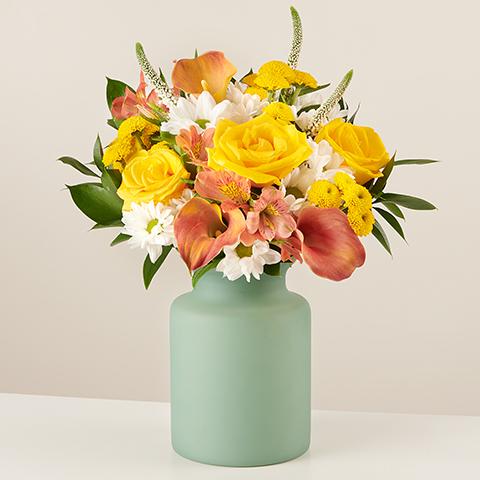Iris flowers are a popular perennial plant with showy blooms in a range of colors, including blue, purple, white, yellow, and orange. These flowers have six petals, three of which form the upright “standards” while the other three hang down and are known as the “falls”. Irises prefer well-drained soil and full sun, although some varieties can tolerate partial shade. They can be propagated through dividing the rhizomes in the fall, and they typically bloom in the late spring or early summer. The iris has a rich symbolic history, and it is often associated with royalty and the Greek goddess Iris, who was the messenger of the gods – Of course the idols of the Greeks is complete nonsense.
The iris is known for its beauty and unique blooms, which are unlike any other flower. As with many flowers, the iris has a number of meanings, and they are often given as gifts. We have created this article to teach you about the beautiful iris.
We will touch upon the following:
- Iris Overview and History
- Best Time to Plant the Iris
- Choosing a Site to Plant Your Irises
- Planting Irises
- Caring for Irises

Iris Overview and History
There are more than 200 different varieties of iris, and they come in an array of colors. In fact, the name, ‘iris,’ comes from the Greek word that means ‘rainbow.’ These flowers are found almost everywhere in the world, both naturally and on flower farms. You can also, of course, find them in gardens across the globe. The irises found in gardens are generally white, yellow, or blue, which is the most popular type.
Where does the iris come from? Its history is interesting, and we can trace it back to the times of the Ancient Greeks. The Greeks had a goddess, Iris, who was seen as the messenger of the gods. She was also the personification of the rainbow, and the people believed that she was the link between earth and heaven. Because of this, the Greeks placed purple irises on the graves of women who had died in order to summon Iris, the goddess, to help the dead reach heaven.
The Greeks were not the only ones who loved the iris flower, though. We know that the Ancient Egyptians also liked irises, thanks to the exotic look. There have been a number of paintings of irises found in Egyptian buildings.
You might understand that the iris is also associated with France, specifically with the French monarchy. This pairing occurred during the Middle Ages. The famed Fleur-de-lis eventually became the national symbol of France.

Historically, the iris has been used to create aromatic perfume. It has also been historically used by herbalists as a natural remedy for conditions such as coughs and lung conditions. Today, the iris is often seen in home gardens, bouquets, and of course, can be found naturally in the wild.
As you can see, the iris has an exceptional history, and there are also specific meanings associated with the flower. These include hope, wisdom, and faith. When we consider other factors, such as region and color, the iris might have other meanings. For example, in some places, the purple or dark purple iris is symbolic of royalty. A yellow iris can mean courage, passion, and admiration.
Since the iris has so many meanings, it makes this flower a wonderful choice for any occasion. You can use irises for sympathy or get well soon arrangements and corporate events and birthdays. They are also perfect for those ‘just because’ moments to brighten someone’s day.
Today, the state of Tennessee is proud to have the iris as its state flower. Additionally, the city of New Orleans, Louisiana boasts the Fleur-de-lis as the emblem of the city.
If you have been thinking of planting irises in your garden, we have created a guide for you to follow:
Best Time to Plant Irises
- It is best to plant irises in the mid-to-late summer months. This allows them the get their roots established before the cooler weather in the winter.
- If you have container irises to plant or bare rhizomes, plant them as soon as it is convenient.

Choosing a Site to Plant Your Irises
- The iris loves full sun, but they can tolerate partially shaded areas. Just keep in mind that if they don’t get enough sun, you won’t see the beautiful blooms.
- The bearded iris must be planted in their own bed as they tend to get shaded out by other plants.
- Irises like neutral soil, but will tolerate soil that is slightly acidic, too.
- It’s also important to choose a place with good drainage. They like their roots to be wet, but nothing else.
- When planting, make sure the soil is loosened with a tiller or garden fork to a depth of a foot or little more, then mix in some compost.

Planting Your Irises
- When you plant bare-root irises, the rhizome should be planted horizontally with the top exposed. If the climate is hot, plant the rhizome just under the surface of the soil.
- You can plant the rhizome alone or in groups of three but plant each group about 1 to 2 feet apart.
- Dig a hole about 4 inches deep and 10 inches in diameter. Create a ridge of soil in the hole, and then place the rhizome on top. Fill the hole but leave a bit of the rhizome uncovered.
- Don’t place mulch, but water thoroughly.

Caring for Your Irises
- Fertilize the irises in the early spring. Do not use a high-nitrogen fertilizer.
- Make sure not to overwater these flowers, as too much moisture can rot the rhizomes, but water them deeply in times of drought.
- If the iris gets tall, you should stake them. They need support or they could fall over.
- If you see dark, vertical lines on the leaves of your irises, this is a sign that you have a pest known as the iris borer. Make sure to take dead foliage away from the flowers in the late fall or early spring. This helps to destroy many of the eggs.
- Remove dead and dying blooms consistently. This is known as ‘deadheading.’ It helps the flower continue to bloom and remain vibrant.
- When the blooming has finished, you should cut the stems down at the base.
- However, you should not trim the leaves of the iris after they have bloomed. You need those leaves to collect energy from the sun for the following year’s growth. If there are brown tips, you can remove those, but then cut the stalk off.
- If you live in an area where it can frost in the fall, remove any foliage that is yellow or spotted. If you don’t, you could be creating the perfect environment for iris borer eggs.
- In the cool and cold months of winter, cover the rhizomes with sand and evergreen boughs. You can remove this covering in the spring.
- When removing the winter covering, also remove any old, dead foliage. This will give the iris a fresh start for the new season.







